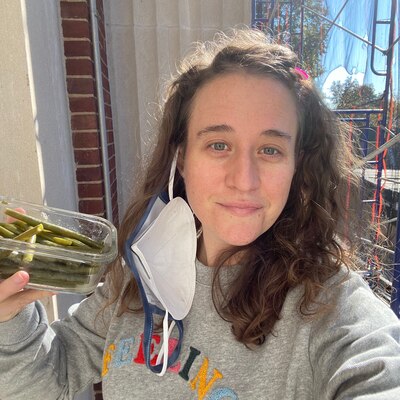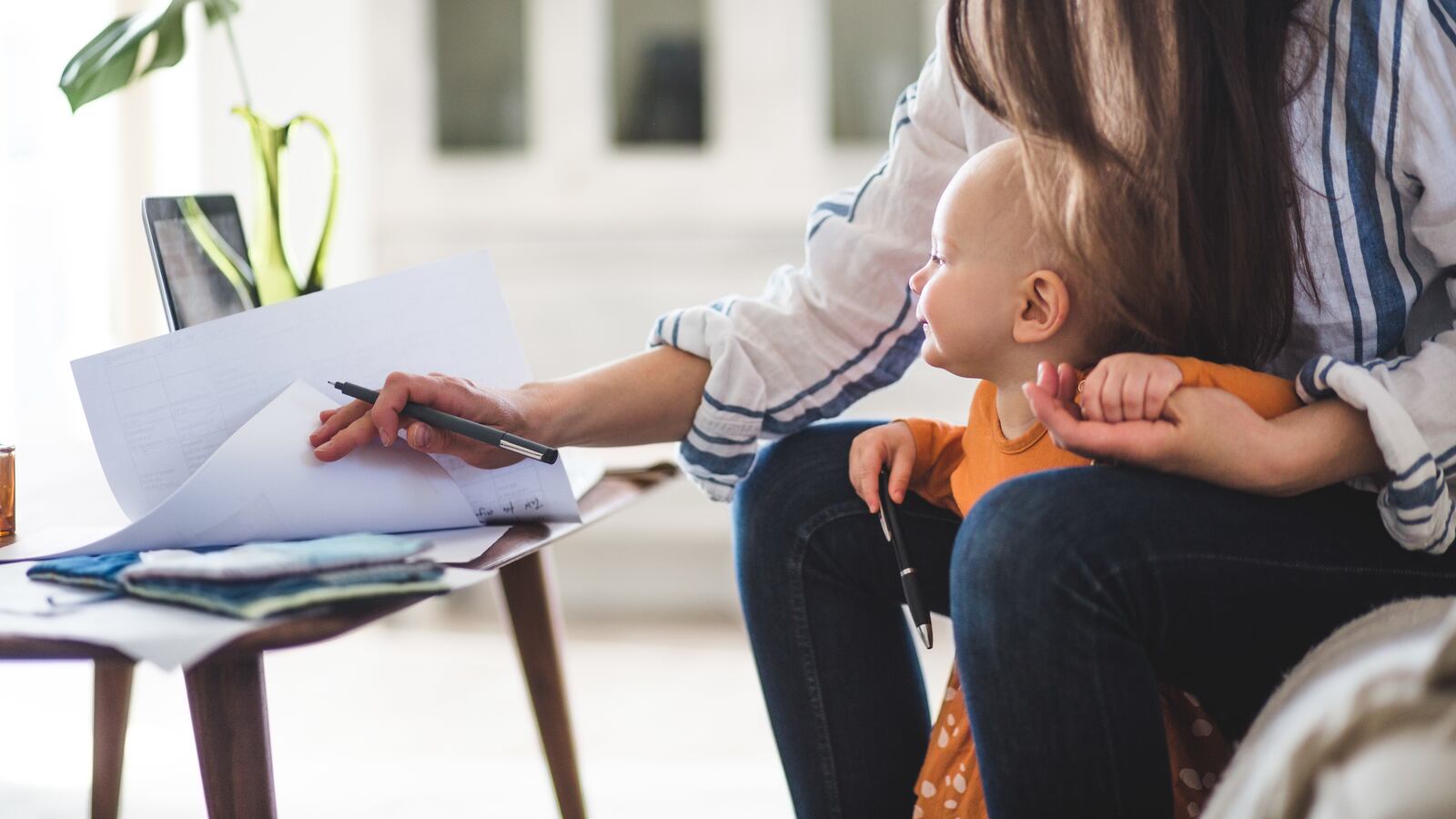When it comes to remote teaching, there’s no hiding anything. My kindergartener is dawdling behind me, eating a strawberry lollipop. One of my high school students remarks, “Miss, she’s a whole mood.” My husband, a middle school math teacher, steps into the frame to grab the laptop so he can teach his classes from the kitchen. Our toddler is wildly flopping onto the bed — and since I am working from my bedroom, my students can see where I sleep.
Our Jackson Heights apartment bedroom has no doors; we temporarily erected a baby fence until she figured out how to weasel her way past it at 13 months.

When I log in to one of my daily Google Meets, I see a tired mom who should probably swipe on some lipstick, start wearing real pants again, and nourish herself with more than peanut butter on a spoon. But my students — they view me as a “cool” adult, offering book recommendations and semi-decent life advice. They see me as someone full of life and humor and all good things. They’ve told me I am #goals.
As a high school librarian, relationship-building has always come first for me, and books are a close second. In the Before Times, I remember showing my educator ID at a bookstore for a teacher discount and saying, “my kids are going to love these books.” The cashier asked if I was buying the books for my own personal use or for my school. My teenage students are mine forever. Plus, since I don’t hand out grades, many teens say they can just be themselves around me.
This year, I am cultivating new relationships, even from a distance. There are students I chat with daily but have yet to meet in real life. A student who encouraged me to watch the same book-to-movie adaptation of “Moxie” so we could debrief about it. I host virtual author visits and book clubs and mail out books to students by printing mailing labels on my pandemic-purchased printer and weighing parcels on my kitchen scale. There’s the student who takes time to tell me as often as possible, “you’re doing great, Ms. K.” There’s another who’s hoping to become a first-generation college student but worries about the lack of family support. One of my most optimistic and joyful students likes to meet with me for some Morning Motivation. The other day, he remarked that he’s “taking the hit” and staying home and socially distant so my own children won’t have to keep living like this much longer. He wants them to have a high school experience uninterrupted by school closures.
Another student confided in me recently, “80% of us teenagers are depressed. School feels kind of pointless and remote learning is making me question the purpose of any of this. We are being told to produce and produce, but for what?” Honestly, he’s not wrong. As adults bemoan a “lost year,” teenagers are simply feeling the loss of interacting with friends. They miss finally being able to act on the independence they were so close to tasting.
Similar to many of my teenage students, I feel trapped in my apartment, tethered to an online school bell. It’s one thing to run daily library programs with students who voluntarily hang out for a social-emotional connection or to kill after-school time. It’s a lot tougher when I pop in to join a class to teach a research lesson and I do not have an already established rapport with the students. It’s not rare to Zoom into a class and see 34 black rectangles with cameras off and mics muted. Teachers are not exactly thriving or living our best lives, either. We are exhausted from trying to connect with our muted students, living period to period, and teaching a not entirely relevant curriculum. Additionally, educators are coping with the fall from being heralded as heroes one year ago to villains a year later. We have no idea if any of our students are paying attention to anything we say or do. Sometimes, it seems like we’re just talking into the void.
Until, one day, you realize, you’re not.
A couple of weeks ago, when New York City middle schools reopened, my husband went back to his school building. My kindergartener was at school “in real life.” During a double period, I was teaching 12th graders about databases, digital research, avoiding plagiarism, and finding credible sources for their thesis papers about “Frankenstein.” The first period went off without a hitch and my toddler ran around content, strewing toys about the apartment. At one point, I confiscated a bottle of shampoo from her as she went to chew on its spout. I bantered with students I hadn’t seen in a year and a half and even got them to show their faces on camera for a quick wave hello. Much like the meme of the cartoon dog in a burning cafe, I was thinking, “this is fine.”
By the time the second class began, the baby was over it. Overtired and listless, I popped her into my baby carrier to get her to rest. Strapped to me, she started putting her fingers in my nose, covering my mouth while I was teaching, and pulling out my AirPods. There was absolutely no camouflaging my struggle. The teacher whose class I was visiting graciously let me know that she could take over for me, that I had done more than enough to prepare the digital resources her students would need. I was sweating through my shirt and my eyes began to brim with tears.
That’s when the chat started to fill.
Students who were rectangles with cameras off, who I have known since they were 13 or 14 wrote: “We love you and we miss you, Ms. K.” “Thank you for all you’ve done for us.” “I have so much compassion for you as a teacher and a mother.” A teenage boy wrote: “You’re a strong mom.” And I sobbed. With the camera on.
Later that afternoon, I took the self-care advice that I often give to my students — I put on a mask, grabbed my AirPods, and went out for a walk while reading an audiobook. I popped my restless daughter into her stroller and stopped in the middle of the road when I heard this passage from the memoir “Wintering” by Katherine May: “We changed our focus away from pushing through with normal life and towards making a new one. When everything is broken, everything is also up for grabs. That’s the gift of winter. It’s irresistible. Change will happen in its wake, whether we like it or not. We can come out of it wearing a different coat.”
As each day seems to blur endlessly into the next, let us remember both the struggles and beauty of this past year. Many of us have gained clarity, purpose and compassion. For many of my students, this was not a “lost” year but a year of self-reflection, discovery, and growth. Teenagers have been given the opportunity to actually stop and think about what they want their world to be like when they can safely rejoin it. They’ve used this past year to think deeply about both who they want to surround themselves with and what they want to leave behind. And in the depths of my own winter, my students reflected back to me what I have always strived to offer to them — empathy, compassion, and honesty.
Lindsay Klemas is a New York City Department of Education high school librarian living and working in Queens, New York. She loves chocolate and peanut butter, #ownvoices YA books, and helping students become lifelong readers.



